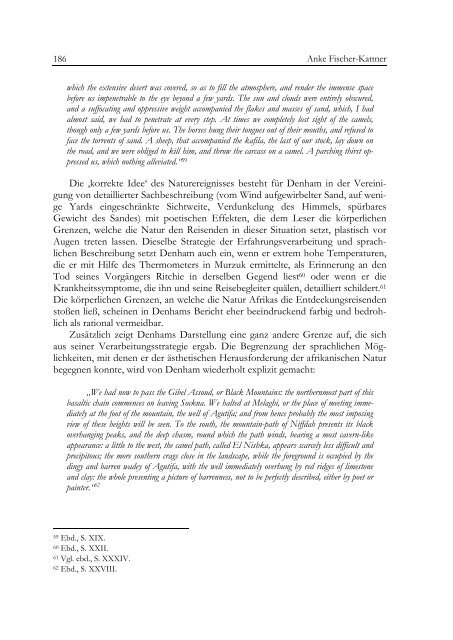Natur als Grenzerfahrung - Oapen
Natur als Grenzerfahrung - Oapen
Natur als Grenzerfahrung - Oapen
Erfolgreiche ePaper selbst erstellen
Machen Sie aus Ihren PDF Publikationen ein blätterbares Flipbook mit unserer einzigartigen Google optimierten e-Paper Software.
186<br />
Anke Fischer-Kattner<br />
which the extensive desert was covered, so as to fill the atmosphere, and render the immense space<br />
before us impenetrable to the eye beyond a few yards. The sun and clouds were entirely obscured,<br />
and a suffocating and oppressive weight accompanied the flakes and masses of sand, which, I had<br />
almost said, we had to penetrate at every step. At times we completely lost sight of the camels,<br />
though only a few yards before us. The horses hung their tongues out of their mouths, and refused to<br />
face the torrents of sand. A sheep, that accompanied the kafila, the last of our stock, lay down on<br />
the road, and we were obliged to kill him, and throw the carcass on a camel. A parching thirst oppressed<br />
us, which nothing alleviated.“ 59<br />
Die ‚korrekte Idee‘ des <strong>Natur</strong>ereignisses besteht für Denham in der Vereinigung<br />
von detaillierter Sachbeschreibung (vom Wind aufgewirbelter Sand, auf wenige<br />
Yards eingeschränkte Sichtweite, Verdunkelung des Himmels, spürbares<br />
Gewicht des Sandes) mit poetischen Effekten, die dem Leser die körperlichen<br />
Grenzen, welche die <strong>Natur</strong> den Reisenden in dieser Situation setzt, plastisch vor<br />
Augen treten lassen. Dieselbe Strategie der Erfahrungsverarbeitung und sprachlichen<br />
Beschreibung setzt Denham auch ein, wenn er extrem hohe Temperaturen,<br />
die er mit Hilfe des Thermometers in Murzuk ermittelte, <strong>als</strong> Erinnerung an den<br />
Tod seines Vorgängers Ritchie in derselben Gegend liest 60 oder wenn er die<br />
Krankheitssymptome, die ihn und seine Reisebegleiter quälen, detailliert schildert. 61<br />
Die körperlichen Grenzen, an welche die <strong>Natur</strong> Afrikas die Entdeckungsreisenden<br />
stoßen ließ, scheinen in Denhams Bericht eher beeindruckend farbig und bedrohlich<br />
<strong>als</strong> rational vermeidbar.<br />
Zusätzlich zeigt Denhams Darstellung eine ganz andere Grenze auf, die sich<br />
aus seiner Verarbeitungsstrategie ergab. Die Begrenzung der sprachlichen Möglichkeiten,<br />
mit denen er der ästhetischen Herausforderung der afrikanischen <strong>Natur</strong><br />
begegnen konnte, wird von Denham wiederholt explizit gemacht:<br />
„We had now to pass the Gibel Assoud, or Black Mountains: the northernmost part of this<br />
basaltic chain commences on leaving Sockna. We halted at Melaghi, or the place of meeting immediately<br />
at the foot of the mountain, the well of Agutifa; and from hence probably the most imposing<br />
view of these heights will be seen. To the south, the mountain-path of Niffdah presents its black<br />
overhanging peaks, and the deep chasm, round which the path winds, bearing a most cavern-like<br />
appearance: a little to the west, the camel path, called El Nishka, appears scarcely less difficult and<br />
precipitous; the more southern crags close in the landscape, while the foreground is occupied by the<br />
dingy and barren wadey of Agutifa, with the well immediately overhung by red ridges of limestone<br />
and clay: the whole presenting a picture of barrenness, not to be perfectly described, either by poet or<br />
painter.“ 62<br />
59 Ebd., S. XIX.<br />
60 Ebd., S. XXII.<br />
61 Vgl. ebd., S. XXXIV.<br />
62 Ebd., S. XXVIII.

















